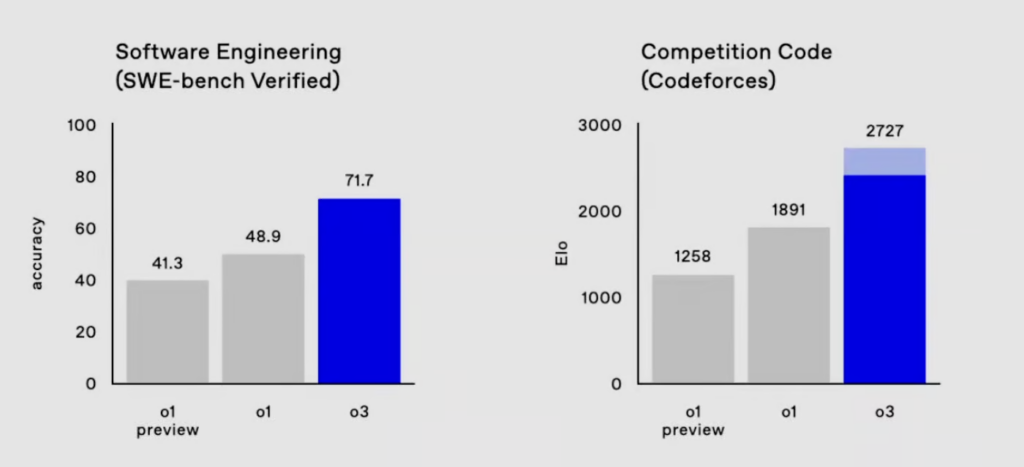If you’ve been keeping up with advancements in artificial intelligence, you’ve likely heard about OpenAI’s latest innovation — the O3 model and its streamlined counterpart, O3 Mini. Following the release of the O1 model in September, which introduced step-by-step reasoning, OpenAI has now taken a significant leap forward with O3. This model isn’t just another incremental improvement; it represents a fundamental shift in AI’s ability to tackle complex coding, mathematics, and scientific reasoning challenges.
A Quick Recap of O1
The O1 model marked an important milestone in AI development by incorporating a methodical, step-by-step reasoning approach. Rather than simply providing answers, O1 would “think aloud,” methodically explaining its logic. This approach allowed it to solve problems in a structured way, making it particularly useful for tasks requiring multi-step reasoning. However, while groundbreaking, O1 had its limitations, especially when dealing with highly complex or novel problems requiring deeper logical abstraction and adaptability.
What Sets O3 Apart?
The O3 model builds on O1’s foundation but significantly enhances its capabilities. It is designed to not only deliver more precise answers but also do so at a faster pace while handling significantly more challenging problems. OpenAI reports that O3 demonstrates remarkable improvements in multiple domains:

Superior Performance on Coding Benchmarks
- On the SWE-bench verified test, designed to evaluate AI-assisted coding, O1 achieved an accuracy rate of 48.9%. O3, however, far exceeded expectations with a 71.7% accuracy.
- On Codeforces, a competitive programming benchmark, O1 scored 1891, while O3 surged to an impressive 2727.
Excellence in Complex Mathematics
- O3 achieved a 96.7% score on AIME 2024, a significant leap from O1’s 83.3%.
- More notably, O3 secured a 25.2% score on the EpochAI Frontier Math benchmark, which focuses on entirely new, unseen problems. In comparison, older AI models typically hovered around a mere 2% on this challenging test.
Advancements in Scientific and Research-Based Reasoning
- The GPQA Diamond test, which evaluates PhD-level scientific reasoning, saw O3 achieve 87.7% accuracy, a strong improvement over O1’s 78%.
The ARC-AGI Benchmark: A True Test of Intelligence
One of O3’s most remarkable achievements is its performance on the ARC-AGI benchmark (Abstraction and Reasoning Corpus for Artificial General Intelligence). This benchmark is unique because it measures an AI’s ability to learn and adapt to entirely new problems—a challenge that traditional AI models have historically struggled with.
Why is this significant? Most AI evaluations focus on pattern recognition and memorization. ARC-AGI, however, requires AI to generalize and think abstractly in novel situations, much like human intelligence. O3’s exceptional performance here signals a major breakthrough, moving AI beyond static knowledge retrieval into dynamic, real-time problem-solving.
Introducing O3 Mini: Scalable Intelligence for Efficiency
Alongside O3, OpenAI has also introduced O3 Mini, a more lightweight yet powerful alternative. Designed for situations where computational resources are limited, O3 Mini is built with adaptive thinking—meaning it can scale its reasoning based on the complexity of the task at hand.
- For straightforward questions, O3 Mini delivers rapid responses using minimal processing power.
- For more intricate problems, it increases computational effort to match the accuracy of the full O3 model, all while operating at a significantly lower cost.
This makes O3 Mini an attractive option for developers, researchers, and businesses that require AI-driven problem-solving without excessive resource consumption. Think of it as a high-performance vehicle that can switch to an energy-efficient mode when needed—balancing power, speed, and cost-effectiveness.
When Will O3 Be Available?
Currently, OpenAI is rolling out O3 and O3 Mini through a private safety testing program. This approach ensures that any potential risks or biases in the models are addressed before they become widely available.
As it stands, OpenAI expects O3 Mini to be released to the public by the end of January 2025, with the full O3 model following shortly afterward.
Final Thoughts: A Generational Leap in AI
O3 isn’t just another AI model—it represents a fundamental evolution in how artificial intelligence can reason, learn, and solve complex problems. By demonstrating high proficiency in coding, mathematics, and scientific research, while excelling in adaptive intelligence benchmarks like ARC-AGI, O3 signals a major shift toward AI systems that do more than just store knowledge—they analyze, adapt, and think.
For researchers, developers, and businesses, the O3 family of models offers groundbreaking opportunities in automation, data analysis, scientific discovery, and beyond. Where AI improvements have often been incremental, O3 stands out as a generational leap, paving the way for more intelligent, efficient, and adaptable AI systems.
If O1 hinted at the future of thoughtful AI, O3 realizes that vision—bringing us closer than ever to AI that doesn’t just process data, but truly understands and reasons through complex challenges in ways once thought impossible.